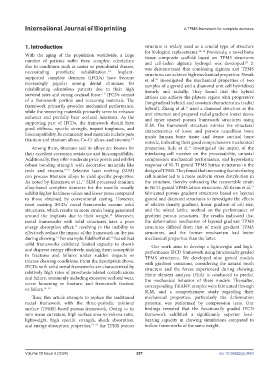Page 265 - IJB-10-5
P. 265
International Journal of Bioprinting A TPMS framework for complete dentures
1. Introduction structure is widely used as a crucial type of structure
for biological replacements. 24–28 Previously, a novel bone
With the aging of the population worldwide, a large tissue composite scaffold based on TPMS structures
number of patients suffer from complete edentulism and cell-laden alginate hydrogel was developed. It
29
due to conditions such as caries or periodontal disease, was demonstrated that combining alginate and TPMS
necessitating prosthetic rehabilitation. 1,2 Implant- structures can achieve high mechanical properties. Novak
supported complete dentures (IFCDs) have become et al. investigated the mechanical properties of two
30
increasingly popular among dental clinicians for samples of a gyroid and a diamond unit cell hybridized
rehabilitating edentulous patients due to their high linearly and radially. They found that the hybrid
survival rates and strong occlusal force. IFCDs consist lattices can achieve the plateau region with progressive
2–5
of a framework portion and veneering materials. The (longitudinal hybrid) and constant characteristics (radial
framework primarily provides mechanical performance, hybrid). Zhang et al. used a diamond structure as the
31
while the veneering materials primarily serve to enhance unit structure and prepared radial gradient (outer dense
esthetics and partially bear occlusal functions. As the and inner sparse) porous framework structures using
supporting part of IFCDs, the framework should have SLM. The framework structure mimics the structural
good stiffness, specific strength, impact toughness, and characteristics of loose and porous cancellous bone
biocompatibility. Its commonly used materials include pure inside human bone tissue and dense cortical bone
titanium and titanium alloys, Co-Cr alloys, and zirconia. 6,7
outside, indicating their good comprehensive mechanical
Among them, titanium and its alloys are known for properties. Jiulu et al. investigated the impact of the
32
their excellent corrosion resistance and biocompatibility. interlacing-cell number on the processability, uniaxial
Additionally, they offer moderate price points and exhibit compression mechanical performance, and hyperelastic
robust bonding strength with decorative materials like response of Ni-Ti gyroid TPMS lattice structures in the
resin and zirconia. 8–10 Selective laser melting (SLM) design of TPMS. They found that increasing the interlacing
can process titanium alloys to yield specific properties. cell number led to a more uniform stress distribution in
As noted by Kanazawa et al., SLM-processed titanium the structure, thereby enhancing the recoverable strain
11
alloy-based complete dentures for the maxilla usually in Ni-Ti gyroid TPMS lattice structures. Al-Ketan et al.
33
exhibit higher hardness values and fewer pores compared fabricated porous gradient structures based on layered
to those obtained by conventional casting. However, gyroid and diamond structures to investigate the effects
most existing IFCDs’ metal frameworks assume solid of relative density gradient, linear gradient of cell size,
structures, which results in more strain being generated and the mixed lattice method on the performance of
around the implants due to their weight. Moreover, gradient porous structures. The results indicated that
12
metal frameworks with solid structures have a poor the deformation mechanism of layered gradient TPMS
energy absorption effect, resulting in the inability to structures differed from that of mesh gradient TPMS
13
effectively reduce the impact of the framework on the jaw structures, and the former mechanism had better
during chewing. For example, Edelhoff et al. found that mechanical properties than the latter.
14
15
solid frameworks exhibited limited capacity to absorb Our work aims to develop a lightweight and high-
and disperse energy effectively, making them susceptible performance IFCD framework using functionally graded
to fractures and failures under sudden impacts or TPMS structures. We developed nine gyroid models
intense chewing conditions. From the description above, with gradient variations, considering the natural tooth
IFCDs with solid metal frameworks are characterized by structure and the forces experienced during chewing.
relatively high rates of prosthesis-related complications Finite element analysis (FEA) is conducted to predict
and failure, commonly including excessive occlusal wear, the mechanical behavior of these models. Thereafter,
screw loosening or fracture, and framework fracture corresponding Ti6Al4V samples were fabricated through
or failure. 16–18 SLM, and a comprehensive study regarding their
Thus, this article attempts to replace the traditional mechanical properties, particularly the deformation
metal framework with the three-periodic minimal patterns, was performed by compression tests. Our
surface (TPMS)-based porous framework. Owing to its findings revealed that the functionally graded IFCD
zero mean curvature, high surface area-to-volume ratio, framework exhibited a significantly superior load-
lightweight, high specific strength, shock absorption, bearing capacity in chewing simulations compared to
and energy absorption properties, 19–23 the TPMS porous hollow frameworks of the same weight.
Volume 10 Issue 5 (2024) 257 doi: 10.36922/ijb.3453

